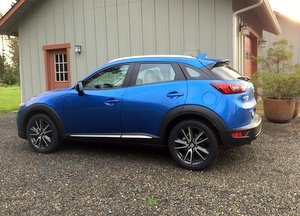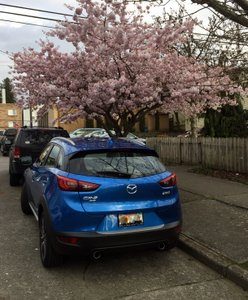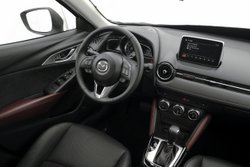A Mighty Mite Full of Tech
Timing is everything in the auto industry. As gas prices have remained at a relatively low level for the last year or so, consumers shifted from economy sedans to larger vehicles—specifically crossovers or car-based SUVs. Car buyers know gas prices may spike sometime in the future, so one tactic is to hedge your bets with a small crossover. The result—compact and subcompact crossover sales have spiked and automakers can’t scramble fast-enough to fill the demand. Mazda’s a great example; the most recent “day’s supply” of cars showed a dramatic split between its car and truck (including crossover) models. Car companies aim for a 60-day supply. Mazda had a 105-day supply of its sedans and only a 71-day supply of crossovers like the 2017 Mazda CX-3 we drove.

Mazda’s CX-3 hit at an opportune time (as has its refresh of the larger CX-5, which we also drove recently). Subcompact crossovers have exploded on the market and provide auto makers much nicer returns than their related subcompact sedans. It’s easy to see why—small crossovers appear to offer the best of both worlds—the good fuel economy and maneuverability of a small car with the functional space of a downsized SUV. Add to that the added bonus of optional all-wheel drive (AWD), and it’s a hard-to-beat package.
The CX-3 is right in the groove with the slightly higher seating position of a crossover, giving you better visibility than in a small sedan, extra storage or hauling space through the rear hatch, great fuel economy, loads of the latest technology and a powerful enough engine for this little wagon to hold its own on the highway. The downside is that small engine means you have to plan some maneuvers ahead of time, such as passing uphill at freeway speeds, and the noise levels are not what you would experience in a larger, more insulated sedan or SUV.
Powertrain
I have to admit, I was captivated with the CX-3 during my time in it, running around the Pacific Northwest. I was able to match the EPA fuel economy numbers and even best them (EPA is 27 city/32 highway/29 combined for AWD models like I drove; 29/35/31 for front-wheel drive). The 2.0-liter engine seemed well matched to the size and weight of the car and the six-speed automatic transmission.
The engine puts out 146 horsepower and 148 pounds-feet of torque, a good example of Mazda Skyactiv engine approach, wringing out some good numbers with a higher compression ratio than typical of engines this size.

Another portion of the Skyactiv system is the suspension, where Mazda’s goal is to deliver a driver-oriented package with good road feel and stability at freeway speeds. That’s a challenge for many small cars, but the CX-3 seemed unfazed when jostling with big rigs on the freeway. What you get as driver of Mazda’s smallest crossover is a car with responsive steering, good braking (aided by technology—more on that later) and road manners that mimic a larger vehicle. I loaded it up with three adults and it didn’t flinch. If I had to pass on a country road, it was able to find reserve power. At freeway speeds, the little four-banger took more coaxing to work its way up to passing vehicles that were moving slower.
Space/Utility

So it’s got some of the “sport”—how about the “utility” of an SUV? The 2017 Mazda CX-3 is a subcompact, so there are compromises with this size. With the rear seat up, it’s only got room for a small suitcase or a few grocery bags. But the back seats do flip down easily and greatly increase the storage area in the back. The hatchback setup makes for easy access. Seating comfort in the rear is surprisingly good. Headroom is good and the seats, while not at all luxurious, are more than adequate for moderate jaunts. My rear seat passengers had no complaints.
Safety
This is a big issue with small vehicles, but it’s a big red herring in many discussions. While generally small vehicles fare less well in crashes against larger and heavier ones, the level of safety in most contemporary small cars and crossovers is quite high. Crash testing by NHTSA bears this out with the 2017 Mazda CX-3 getting a top 5-star rating across the board.
The tougher Insurance Institute for Highway Safety tests gave the CX-3 a “good” rating and noted it had “superior” front crash protection with its optional “Smart Brake Support” system. We found the safety equipment acquitted itself well on our city and highway travels.
Price/Technology
The 2017 Mazda CX-3 starts with the Sport at $19,960 for the front-wheel-drive model with 16-inch wheels and a solid lineup of standard equipment, including a rearview camera, air conditioning and a full contingent of apps in the Mazda Connect infotainment system. Next step up is the Touring model at $21,960 with 18-inch wheels. It adds leatherette-trimmed, heated seats among other goodies.
The top-line model is the Grand Touring (which was our tester), which starts at $24,990 and includes LED headlights, daytime running lights, taillights and fog lights, among other upgrades. It moves up to full leather seats and adds a navigation system along with a variety of safety technology.
Throughout the lineup adding all-wheel drive boosts the price by $1,250 and knocks two mpg off of the highway fuel economy. I found the EPA combined estimate of 29 mpg was pretty easy to beat as I hit a high of 33.3 mpg and a low of 30.9 in various runs.

The level of technology standard or available in this little car was the biggest surprise. The Sport model starts with the Mazda Connect infotainment system with a seven-inch touchscreen augmented by a very intuitive rotary knob (shades of the old BMW iDrive, but better) and voice command as well as a rearview camera. The mid-level Touring adds blind spot monitoring and rear cross traffic alert.
At the Grand Touring level the audio system moves up to a Bose seven-speaker setup, a navigation system is added along with the Active Driving Display, Mazda’s name for a clever head-up display. Beyond all of this technology an optional package (at $1,170) can add radar (adaptive) cruise control, automatic braking (two systems actually, one for low speeds and one for higher speeds), rain-sensing wipers and a very sensitive lane departure warning system. I highly recommend this optional package—rain-sensing wipers in the Pacific Northwest with its intermittent precipitation are a must, the radar cruise control was a delight on the shifting speeds of rush hour traffic and the brake assist systems were very reassuring and helpful.
Summary
The 2017 Mazda CX-3 enters an automotive territory that has grown increasingly crowded. By the end of the year, we suspect everyone will have a player in this hot category. Here’s the list (not counting several luxury entrants and some slightly larger models that may play in this space), by current 2017 sales:
- Jeep Renegade
- Honda HR-V
- Chevrolet Trax
- Kia Niro
- Mazda CX-3
- Nisan Juke
- Fiat 500X
- Toyota CH-R
- Coming Soon—Ford EcoSport
- Hyundai?

We’ve been in most of these and can see why Mazda is moving up the list. It doesn’t have the style or off-road cred of the Jeep Renegade or the performance of the Nissan Juke Nismo, but it’s a healthy competitor for the Honda and Chevrolet. It’s got a genuine style of its own so, even if Mazda doesn’t have the distribution network of those two giant competitors, it’s not a surprise if it holds its own. The technology available at this entry-level model is impressive and its cost is reasonable (some of it is even standard equipment at different trim levels). We enjoyed the 2017 Mazda CX-3 and expect to see more of them out on the road.
SRO-Second Road Test Opinion
In order to give you, the reader, the best perspective on the many vehicles available, Clean Fleet Report has a variety of contributors. When possible, we will offer you multiple perspectives on a given vehicle. This comes under SRO-Second Road Test Opinion. We hope you’ll enjoy these diverse views–some are just below—and let us know what you think in comments below or at publisher@cleanfleetreport.com.
Road Test: 2017 Mazda CX-3 (Larry’s view)
Related Stories You Might Enjoy:
Road Test: 2017 Jeep Renegade
Road Test: 2016 Honda HR-V
Road Test: 2015 Chevrolet Trax
Road Test: 2017 Kia Niro (Larry’s view)
Road Test: 2017 Kia Niro (Steve’s view)
Road Test: 2017 Kia Niro (John’s view)
Road Test: 2015 Nissan Juke (or the Nismo version)
Road Test: 2016 Fiat 500X
Disclosure:
Clean Fleet Report is loaned free test vehicles from automakers to evaluate, typically for a week at a time. Our road tests are based on this one-week drive of a new vehicle. Because of this we don’t address issues such as long-term reliability or total cost of ownership. In addition we are often invited to manufacturer events highlighting new vehicles or technology. As part of these events we may be offered free transportation, lodging or meals. We do our best to present our unvarnished evaluations of vehicles and news irrespective of these inducements.
Our focus is on vehicles that offer the best fuel economy in their class, which leads us to emphasize electric cars, plug-in hybrids, hybrids and diesels. We also feature those efficient gas-powered vehicles that are among the top mpg vehicles in their class. In addition, we aim to offer reviews and news on advanced technology and the alternative fuel vehicle market. We welcome any feedback from vehicle owners and are dedicated to providing a forum for alternative viewpoints. Please let us know your views at publisher@cleanfleetreport.com.

6 thoughts on “Road Test: 2017 Mazda CX-3 Grand Touring AWD”